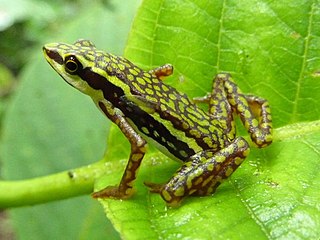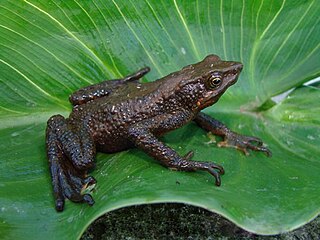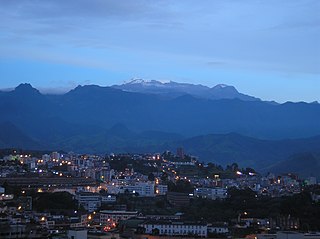
The starry night toad is a species of toad in the family Bufonidae endemic to the Sierra Nevada de Santa Marta, Colombia. Its natural habitats are sub-Andean and Andean forests, sub-páramo and páramo at 2,000–3,500 m (6,600–11,500 ft) above sea level. Reproduction takes place in fast-flowing rivers. It is named after its unique coloration, being largely black with white spots.

Atelopus certus, the Darien stubfoot toad or Toad Mountain harlequin frog, is a species of toad in the family Bufonidae endemic to Panama.
Atelopus chocoensis, the Chocó stubfoot toad, is a species of toad in the family Bufonidae endemic to Colombia. Its natural habitat is subtropical or tropical moist montane forests. It is threatened by habitat loss.

Atelopus coynei, the Rio Faisanes stubfoot toad, is a species of toad in the family Bufonidae endemic to Ecuador. Its natural habitats are subtropical or tropical moist lowland forests, subtropical or tropical moist montane forests, and rivers. It is threatened by habitat loss.
Atelopus galactogaster, the Antado stubfoot toad, is a species of toad in the family Bufonidae endemic to Colombia within the northwestern Andean montane forests. The species' natural habitat is subtropical or tropical moist montane forests.

Atelopus glyphus, the Pirri harlequin frog or Pirri Range stubfoot toad, is a species of toad in the family Bufonidae found in Colombia and Panama within the Northwestern Andean montane forests. Its natural habitats are subtropical or tropical moist montane forests and rivers.
The Guanujo stubfoot toad, known in Spanish as puca sapo, is a species of toads in the family Bufonidae endemic to Ecuador. Its natural habitats are subtropical or tropical moist montane forests and rivers. It is threatened by habitat loss.
Atelopus halihelos, the Morona-Santiago stubfoot toad, is a species of toad in the family Bufonidae endemic to Ecuador. Its natural habitats are subtropical or tropical moist montane forests and rivers. It is threatened by habitat loss.

Atelopus laetissimus is a species of toad in the family Bufonidae. It is endemic to Colombia and only known from the area of its type locality in the northwestern part of the Sierra Nevada de Santa Marta, in the Magdalena Department.
Atelopus minutulus is a species of toad in the family Bufonidae. It is endemic to Colombia. Its natural habitats are subtropical or tropical moist montane forests and rivers. It is threatened by habitat loss.

Atelopus nahumae is a species of toad in the family Bufonidae. It is endemic to Colombia and only known from humid montane forest of Sierra Nevada de Santa Marta in the Magdalena, La Guajira, and Cesar Departments.
Atelopus nicefori is a species of toad in the family Bufonidae. It is endemic to Colombia. Its natural habitats are subtropical or tropical moist montane forests and rivers. It is threatened by habitat loss.
Atelopus petriruizi, more commonly known as the painted stubfoof toad, is a species of toad in the family Bufonidae. Endemic to Colombia, the toad's natural habitats are subtropical or tropical moist montane forests and rivers. Threatened by habitat loss, the Ateopus petriruizi is currently classified as critically endangered, and was placed on the IUCN red list in 2017. Currently, there may be less than 49 remaining mature A. Petriruizi.
The green and red venter harlequin toad is a species of toad in the family Bufonidae. It is endemic to Venezuela. Its natural habitats are subtropical or tropical moist montane forests, rivers, and intermittent rivers. It is threatened by habitat loss.
Atelopus quimbaya is a species of toad in the family Bufonidae. It is endemic to Colombia and known from the western slopes of the Cordillera Central in Risaralda, Quindío, and Caldas Departments. Its natural habitats are sub-Andean and Andean forests at altitudes of 1,650–2,940 m (5,410–9,650 ft) above sea level. Chytridiomycosis is a serious risk to this rare species.
The scarlet harlequin toad or sapito arlequin de Soriano is a species of toad in the family Bufonidae. It is endemic to Venezuela. Its natural habitats are subtropical or tropical moist montane forests and rivers. It is threatened by habitat loss. It may already be extinct. The toad is among the 25 “most wanted lost” species that are the focus of Global Wildlife Conservation's “Search for Lost Species” initiative.
Atelopus walkeri, Walker's stubfoot toad, is a species of toad in the family Bufonidae endemic to Colombia. Its natural habitats are subtropical or tropical moist montane forests and rivers. It is threatened by habitat loss.

The Northwestern Andean montane forests (NT0145) is an ecoregion on the Andes mountains in the west of Colombia and Ecuador. Both flora and fauna are highly diverse due to effect of ice ages when the warmer climate zones were separated and the cooler ones combined, and interglacial periods when the reverse occurred. Because the environment is hospitable to humans, the habitat has been drastically modified by farming and grazing since the Pre-Columbian era.

The Cauca Valley montane forests (NT0109) is an ecoregion in western Colombia. It covers the sides of the Cauca Valley, which runs from south to north between the Central and Western Ranges (cordilleras) of the Colombian Andes. The ecoregion is home to very diverse fauna and flora, due in part to its varied elevations and climates, in part to its position near the isthmus of Panama, the route along which North American species invaded South America and then diversified as they moved to the upper parts of the Andes. Little of the original habitat remains at lower levels, but higher up there are sizeable blocks of forest, some of which are protected.

The Eastern Cordillera Real montane forests (NT0121) is an ecoregion in the eastern range of the Andes of southern Colombia, Ecuador and northern Peru. The ecoregion covers the eastern slopes of the Andes, and includes montane forest that rises from the Amazonian rain forest, with cloud forest and elfin forest at higher elevations. It is rich in species, including many endemics. It is threatened by logging and conversion for pasturage and subsistence agriculture.









